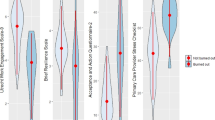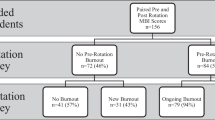Abstract
BACKGROUND
Physician burnout and distress has been described in national studies of practicing physicians, internal medicine (IM) residents, IM clerkship directors, and medical school deans. However, no comparable national data exist for IM residency program directors.
OBJECTIVE
To assess burnout and distress among IM residency program directors, and to evaluate relationships of distress with personal and program characteristics and perceptions regarding implementation and consequences of Accreditation Council for Graduate Medical Education (ACGME) regulations.
DESIGN AND PARTICIPANTS
The 2010 Association of Program Directors in Internal Medicine (APDIM) Annual Survey, developed by the APDIM Survey Committee, was sent in August 2010 to the 377 program directors with APDIM membership, representing 99.0 % of the 381 United States categorical IM residency programs.
MAIN MEASURES
The 2010 APDIM Annual Survey included validated items on well-being and distress, including questions addressing quality of life, satisfaction with work-life balance, and burnout. Questions addressing personal and program characteristics and perceptions regarding implementation and consequences of ACGME regulations were also included.
KEY RESULTS
Of 377 eligible program directors, 282 (74.8 %) completed surveys. Among respondents, 12.4 % and 28.8 % rated their quality of life and satisfaction with work-life balance negatively, respectively. Also, 27.0 % reported emotional exhaustion, 10.4 % reported depersonalization, and 28.7 % reported overall burnout. These rates were lower than those reported previously in national studies of medical students, IM residents, practicing physicians, IM clerkship directors, and medical school deans. Aspects of distress were more common among younger program directors, women, and those reporting greater weekly work hours. Work–home conflicts were common and associated with all domains of distress, especially if not resolved in a manner effectively balancing work and home responsibilities. Associations with program characteristics such as program size and American Board of Internal Medicine (ABIM) pass rates were not found apart from higher rates of depersonalization among directors of community-based programs (23.5 % vs. 8.6 %, p = 0.01). We did not observe any consistent associations between distress and perceptions of implementation and consequences of program regulations.
CONCLUSIONS
The well-being of IM program directors across domains, including quality of life, satisfaction with work-life balance, and burnout, appears generally superior to that of medical trainees, practicing physicians, and other medical educators nationally. Additionally, it is reassuring that program directors' perceptions of their ability to respond to current regulatory requirements are not adversely associated with distress. However, the increased distress levels among younger program directors, women, and those at community-based training programs reported in this study are important concerns worthy of further study.





Similar content being viewed by others
REFERENCES
Dyrbye LN, Thomas MR, Massie FS, et al. Burnout and suicidal ideation among U.S. medical students. Ann Intern Med. 2008;149:334–41.
West CP, Shanafelt TD, Kolars JC. Quality of life, burnout, educational debt, and medical knowledge among internal medicine residents. JAMA. 2011;306:952–60.
Shanafelt TD, Boone S, Tan L, et al. Burnout and satisfaction with work-life balance among US physicians relative to the general US population. Arch Intern Med. 2012;172:1377–85.
Dyrbye LN, Shanafelt TD, Thomas MR, Durning SJ. Brief observation: a national study of burnout among internal medicine clerkship directors. Am J Med. 2009;122:310–2.
Gabbe SG, Wenn LE, Moore DE, Harrell FE Jr, Spickard WA Jr, Powell R Jr. Burnout in medical school deans: an uncommon problem. Acad Med. 2008;83:476–82.
Beasley BW, Kern DE, Howard DM, Kolodner K. A job-satisfaction measure for internal medicine program directors. Acad Med. 1999;74:263–70.
Beasley BW, Kern DK, Kolodner K. Job turnover and its correlates among residency program directors in internal medicine—a three year cohort study. Acad Med. 2001;76:1127–35.
Hinchey KT, McDonald FS, Beasley BW. Sources of satisfaction: a second administration of the Program Director Satisfaction Survey. Am J Med. 2009;122:196–201.
Shanafelt TD, Sloan JA, Habermann TM. The well-being of physicians. Am J Med. 2003;114:513–7.
American Medical Association. Graduate medical education: FREIDA Online. Available at: http://www.ama-assn.org/ama/pub/education-careers/graduate-medical-education/freida-online.page. Accessed December 27, 2012.
Accreditation Council for Graduate Medical Education. Search, Accredited Programs, Internal medicine. Available at: http://www.acgme.org/adspublic/. Accessed December 27, 2012.
Association of Program Directors in Internal Medicine. 2010 APDIM Program Directors Survey - Summary File. http://www.im.org/toolbox/surveys/APDIMSurveyData/Documents/2010_APDIM_summary_web.pdf. Accessed December 27, 2012.
Spitzer WO, Dobson AJ, Hall J, et al. Measuring the quality of life of cancer patients: a concise QL-index for use by physicians. J Chron Dis. 1981;34:585–97.
Gudex C, Dolan P, Kind P, Williams A. Health state valuations from the general public using the visual analogue scale. Qual Life Res. 1996;5:521–31.
Rummans TA, Clark MM, Sloan JA, et al. Impacting quality of life for patients with advanced cancer with a structured multidisciplinary intervention: a randomized controlled trial. J Clin Oncol. 2006;24:635–42.
West CP, Huschka MM, Novotny PJ, et al. Association of perceived medical errors with resident distress and empathy: a prospective longitudinal study. JAMA. 2006;296:1071–8.
West CP, Tan AD, Habermann TM, Sloan JA, Shanafelt TD. Association of resident fatigue and distress with perceived medical errors. JAMA. 2009;302:1294–300.
Linn LS, Yager J, Cope D, Leake B. Health status, job satisfaction, job stress, and life satisfaction among academic and clinical faculty. JAMA. 1985;254:2775–82.
Keeton K, Fenner DE, Johnson TR, Hayward RA. Predictors of physician career satisfaction, work-life balance, and burnout. Obstet Gynecol. 2007;109:949–55.
Balch CM, Shanafelt TD, Dyrbye LN, et al. Surgeon distress as calibrated by hours worked and nights on call. J Am Coll Surg. 2010;211:609–19.
Dyrbye LN, Shanafelt TD, Balch CM, Satele D, Sloan JA, Freischlag J. Relationship between work–home conflicts and burnout among American surgeons: a comparison by sex. Arch Surg. 2011;146:211–7.
Dyrbye LN, West CP, Satele D, Sloan JA, Shanafelt TD. Work/home conflict and burnout among academic internal medicine physicians. Arch Intern Med. 2011;171:1207–9.
Spitzer RL, Williams JB, Kroenke K, et al. Utility of a new procedure for diagnosing mental disorders in primary care: the PRIME-MD 1000 study. JAMA. 1994;272:1749–56.
Whooley MA, Avins AL, Miranda J, Browner WS. Case-finding instruments for depression: two questions are as good as many. J Gen Intern Med. 1997;12:439–45.
Shanafelt TD, Bradley KA, Wipf JE, Back AL. Burnout and self-reported patient care in an internal medicine residency program. Ann Intern Med. 2002;136:358–67.
Shanafelt TD, Balch CM, Dyrbye LN, et al. Special report: suicidal ideation among American surgeons. Arch Surg. 2011;146:54–62.
Williams JW Jr, Noel PH, Cordes JA, Ramirez G, Pignone M. Is this patient clinically depressed? JAMA. 2002;287:1160–70.
Maslach C, Jackson SE, Leiter MP. Maslach Burnout Inventory Manual. 3rd ed. Palo Alto, CA: Consulting Psychologists Press; 1996.
Rafferty JP, Lemkau JP, Purdy RR, Rudisill JR. Validity of the Maslach Burnout Inventory for family practice physicians. J Clin Psychol. 1986;42:488–92.
Thomas NK. Resident burnout. JAMA. 2004;292:2880–9.
West CP, Dyrbye LN, Sloan JA, Shanafelt TD. Single item measures of emotional exhaustion and depersonalization are useful for assessing burnout in medical professionals. J Gen Intern Med. 2009;24:1318–21.
West CP, Dyrbye LN, Satele DV, Sloan JA, Shanafelt TD. Concurrent validity of single-item measures of emotional exhaustion and depersonalization in burnout assessment. J Gen Intern Med. 2012. doi:10.1007/s11606-012-2015-7.
Wolfsthal SD, Beasley BW, Kopelman R, et al. Benchmarks of support in internal medicine residency training programs. Acad Med. 2002;77:50–6.
Shanafelt TD, West CP, Sloan JA, et al. Career fit and burnout among academic faculty. Arch Intern Med. 2009;169:990–5.
Acknowledgements
We are grateful for the support of APDIM, the members of the APDIM Survey Committee, and the residency program directors who completed the APDIM survey. The Mayo Clinic Survey Research Center provided assistance with the survey design and data collection. This study was supported in part by the Mayo Clinic Internal Medicine Residency Office of Educational Innovations as part of the ACGME Educational Innovations Project. This paper does not constitute an official policy statement of APDIM, the APDIM Council, or any other organization with which any of the authors may be affiliated.
Conflict of Interest
The authors declare that they do not have a conflict of interest.
Author information
Authors and Affiliations
Corresponding author
Rights and permissions
About this article
Cite this article
West, C.P., Halvorsen, A.J., Swenson, S.L. et al. Burnout and Distress Among Internal Medicine Program Directors: Results of A National Survey. J GEN INTERN MED 28, 1056–1063 (2013). https://doi.org/10.1007/s11606-013-2349-9
Published:
Issue Date:
DOI: https://doi.org/10.1007/s11606-013-2349-9




